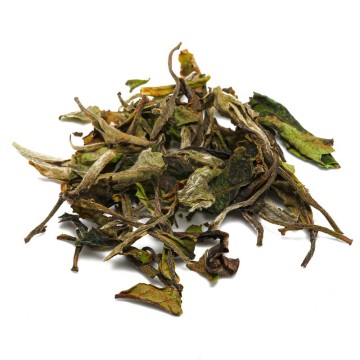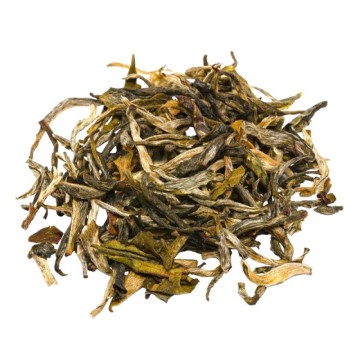A seductive infusion, which releases its notes of lemon and lemongrass to refresh the palate and open to hints of ginger. Enriched with these spicy and citrus flavors, this fruity white tea is lively to the taste and beneficial for the body.
Its Pai Mu Tan white tea base gives the infusion a delicate and soft flavor, which pairs well with Chun Mee green tea leaves. The aromatic and slightly spicy notes that follow evoke the exotic Orient and are suitable for all seasons. White tea with lemon and ginger, with its freshness and low caffeine content, can be enjoyed for a tasty break at any time of the day.
What are the properties of white tea with ginger and lemon?
This type of infusion provides various antioxidants in combination. Pai Mu Tan and Chun Mee white tea contain polyphenols, which are useful for fighting free radicals and their damage to our cells. The antioxidant effect is enhanced by ginger, which also provides detox effects to fight irritation, working together with lemongrass in a purifying infusion. In particular, this ginger and lemon white tea supports proper digestion, helping to relieve symptoms of indigestion, heaviness, nausea and bloating. In the blend, the tea is nutritionally enriched with lemongrass and lemon peels, which further promote proper digestion (citric acid, malic acid, limonene); as well as strengthening the immune system.
This drink is perfect for helping food transit, especially after heavy meals, and for promoting purification, calming irritation. For those looking for a detoxifying infusion, this tea can certainly be useful for our digestive system and for its diuretic effect. It facilitates the expulsion of excess fluids, fighting water retention.
Even in weight management, the combination of tea, ginger and lemon can help within a healthy diet: the active compounds such as zingerone and shogaols, caffeine and polyphenols present in tea help stimulate metabolism and fat burning.
Ginger also contains compounds with properties that can contribute to the regular functioning of the cardiovascular system and normal blood circulation. Furthermore, historically these ingredients were useful against nasal congestion due to excess mucus, during the winter period. The hot infusion of tea, lemon and ginger clears a stuffy nose and soothes a sore throat.
How to buy our ginger and lemon white tea?
This is a fine tea blend that is not common to find in normal supermarkets. We have included it in the Natura d'Oriente selection, among the best loose white teas for sale online. You can order it and get it quickly, with home delivery or at a sorting point. White tea ginger and lemon is available in freshness-saving packs of 25 g, 50 g, 75 g, 100 g, 150 g and 300 g.
How to prepare white tea
Place about 3-5 grams of the mixture in a cup (250 ml) (in a strainer or infuser). Heat the water to 70-80 °C and pour it into the cup, leaving the infusion for 2 to 3 minutes. These temperatures are recommended for infusion, because the white tea buds are fragile and could be damaged.
The origin of the white tea ginger and lemon blend
It combines different ingredients. Pai Mu Tan is the base of loose leaf white tea, the most popular in China also known as White Peony Tea. Its history has its roots in the Fujian province over a millennium ago - it is one of the oldest tea varieties in existence. Pai Mu Tan tea is obtained from the buds and apical leaves, the first two leaves of the tea plant, which have a combination of silvery buds and green leaves. Hand-picked in early spring, in March or April, the buds and leaves are withered and dried. They undergo a minimal oxidation process, left to dry naturally in the sun or in controlled indoor environments. This process allows the leaves to lose moisture, develop aroma and preserve delicate flavors. Finally, the leaves are gently dried to stop oxidation, maintaining the freshness and delicacy of this tea.
This blend contains Chun Mee, a very popular green tea in China, soft and only slightly sweet; with floral notes suitable for combining with white tea. It is also known as "precious eyebrow tea" due to the shape of its leaves. Traditionally grown in Jiangxi Province, it is now widespread throughout China.
Ginger tea also has a long history, dating back about 5,000 years in China, where it was used as a health tonic. For this reason, combining the two ingredients was natural. In addition, the traditione of ginger and lemon herbal tea has occupied a prominent position for centuries.
This blend of the spicy warmth of ginger and the refreshing taste of lemon was already appreciated in ancient times for its invigorating aroma, pungent flavor and wealth of benefits. Ancient Eastern civilizations used both ginger and lemon for their gastronomic and medicinal properties. Ginger was cultivated in India and China thousands of years ago, also used for its supposed ability to relieve ailments such as nausea, indigestion and irritation.
Lemon, rich in vitamin C, was also highly appreciated and the combination was natural to aid digestion, strengthen the immune system, soothe sore throats and coughs. With the expansion of trade routes, lemon and ginger tea spread throughout the world and soon also joined with white and green tea, for a delicious and beneficial infusion.
White tea ginger and lemon what are the side effects
Considered safe for adults, this tea does however have some risks to keep in mind. Although in a reduced amount, this blend of white and green tea contains caffeine - which can also vary depending on the infusion time and the temperature of the water. The effects of caffeine can be harmful if the doses are excessive: agitation, diarrhea, difficulty sleeping, accelerated heartbeat, headache. In addition, the presence of ginger and lemon can cause heartburn, acidity and gastric reflux in sensitive people. For this reason, it is advisable to maintain a moderate consumption of tea (1-2 cups a day).











 No reward points for this product.
No reward points for this product.







![tea white orange spices [Natura d'Oriente]](https://www.naturadoriente.com/3364-home_default/white-tea-orange-and-spices.jpg)